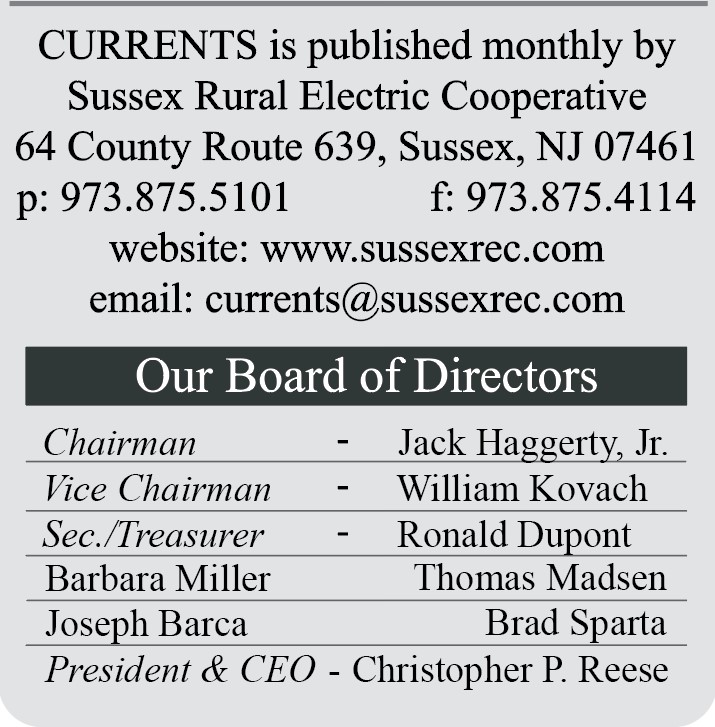To view the full print/pdf version of this issue of Currents, click here
For previous issues of Currents, visit our Currents Library
Going Underground
By: Chris Reese, President & CEO
Email: contacttheceo@sussexrec.com
It is never a good feeling when your power goes out. To best serve our members, Sussex Rural Electric Cooperative invests a lot of time and money into mitigating outages. Unfortunately, not all of them can be easily prevented. Most outages occur when trees or branches cause damage to overhead power lines which, as you all know, is a common factor in a heavily wooded area like ours no matter how much we trim.
Following an outage, one of the most common things we hear from members is the same suggestion: put the power lines underground. This certainly makes sense as an idea. Converting to underground lines can make outages less likely by protecting electric wire from common overhead threats like trees or small animals. Underground lines also have more protection from most weather events.
However, going underground is very costly. The material is more expensive to purchase and install, and when an outage does occur, it may last longer due to the additional time needed to locate faults and excavate the wire. Sussex Rural Electric Cooperative has over 700 miles of power lines throughout its hilly service territory. If you have tried planting something in your yard, you know that our rocky terrain is not conducive to putting miles of line underground. To make something like this work would cost hundreds of millions dollars. Converting all, or even just a large portion, of SREC’s lines to underground would end up increasing service costs and, as a result, your monthly bills.
Despite the logistical and budgetary concerns, these requests have not fallen on deaf ears. As part of its mission to provide the highest quality of service at the lowest possible cost, Sussex Rural Electric Cooperative has a history of undertaking ambitious projects to improve the reliability and resiliency of our system. While we won’t be undergrounding all of our lines, we have been exploring strategic uses of underground power lines that can support our existing infrastructure.
Recently, we undertook a major project to add underground lines to a critical portion of the system. This was touched on briefly in the Annual Report that was sent out as May’s issue of Currents. Here, I aim to share more details of this plan designed to give SREC more options in preventing outages, rather than just fixing them.
This project was focused not just on adding secure, underground power lines to a sensitive area, but creating a redundant feed to the same areas as an existing overhead transmission line. The preexisting overhead transmission line runs through a particularly remote, mountainous, and tree-lined region of Vernon. This means that making repairs here in the event of damage is particularly difficult and time-consuming.
The overhead line was originally built in the 1970s and the time is coming to replace its poles and hardware. Doing so would be difficult due to lack of access and no easy way to deenergize the line for our crews to work on it safely. Adding a redundancy in this location means we can more easily make the needed updates while keeping the majority of our system powered on.
This is why we devised the plan to install a new underground line that would run within the same rights-of-way as the existing overhead line. Phase one of this project involved creating a new underground 34.5kV transmission line that runs through Vernon between two of our delivery points, where we receive power from the wider electric grid.
Having this in place allows for easier replacement of the aging poles and maintenance of existing overhead components without having to use an extended planned outage to get the work done safely. In addition, the underground lines will keep our members powered on even if there is damage to the overhead lines in the future. The overhead lines will also give us coverage if any potential faults occur underground, so excavation time would not add to total outage time.
 The process of installing these new power lines underground was complicated and required the use of large crews and rented equipment such as a directional boring machine. The new underground line had to be directionally bored from Mott Drive to the top of the mountain and then trenched to a riser pole in the woods behind our Vernon substation. Tree removal in these areas was also required in order to best complete the work.
The process of installing these new power lines underground was complicated and required the use of large crews and rented equipment such as a directional boring machine. The new underground line had to be directionally bored from Mott Drive to the top of the mountain and then trenched to a riser pole in the woods behind our Vernon substation. Tree removal in these areas was also required in order to best complete the work.
Work on this project began in October of 2021 and the lines were energized on March 29, 2022. The new underground line is now immune from trees and the elements and is sized large enough to allow for future expansion if needed. This will become the primary feed for our substations in Vernon and Barry Lakes. It represents an investment of about $1.5 million into the security of our system.
This project was a big undertaking for a small cooperative like SREC but it was a necessary step in ensuring that we can properly maintain our system and keep power flowing under the harshest conditions. We are now planning for phase two of this project in which we will be rebuilding the aged overhead lines. This will take place across the next five years or so. After phase two is completed, both the underground and overhead transmission lines will be able to back each other up for decades to come.
This type of long-term planning is very important to keeping our service as high quality as possible. This project was a lot of work, but it was completed smoothly thanks to the dedication and talent of our crews and the planning our management team put into the project. While SREC may not be able to put all of its lines underground, we do actively look for opportunities to add an additional level of security in areas where it makes the most sense for our system. This will allow us to keep delivering on our mission of providing the highest quality of service at the lowest possible cost!





